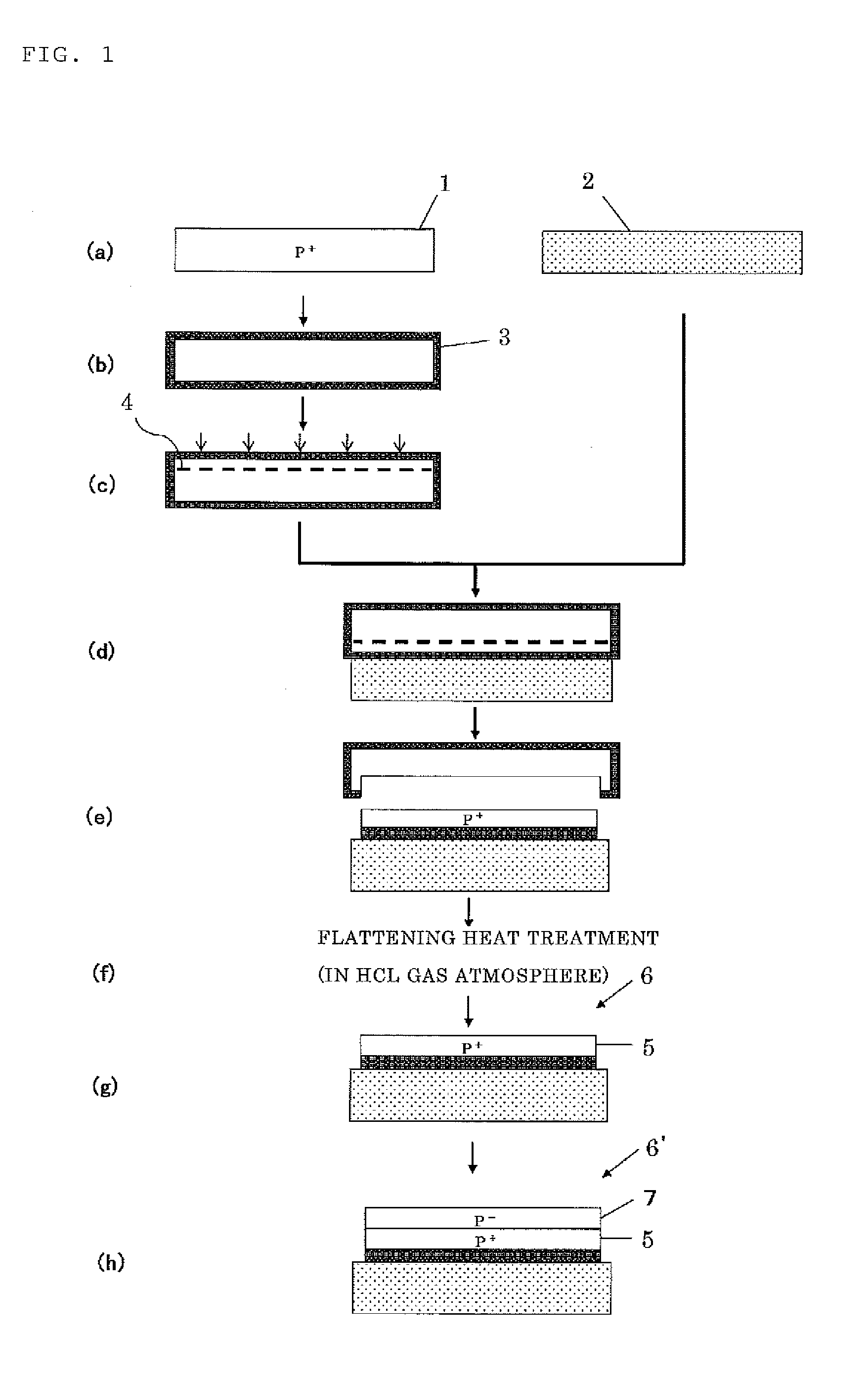Method for manufacturing bonded wafer
a technology of bonded wafers and bonded layers, which is applied in the direction of semiconductor/solid-state device manufacturing, basic electric elements, electric apparatus, etc., can solve the problems of reducing the dopant concentration of the soi layer surface, the radial distribution of the soi film thickness of the cmp process deteriorates, and the desired electrical resistivity cannot be maintained, so as to achieve low resistivity, improve the film thickness distribution, and reduce the effect of oxidation
- Summary
- Abstract
- Description
- Claims
- Application Information
AI Technical Summary
Benefits of technology
Problems solved by technology
Method used
Image
Examples
example 1 (
Example 1(a), Example 1(b), and Comparative Example
[0057]Three SOI wafers in Table 2 described below among the SOI wafers after the delamination manufactured in the above Experiment were thinned by gas etching with HCl. The surface roughness (RMS and R-V) of each wafer is given in Table 2.
[0058]When the low resistivity wafer was used as the bond wafer, i.e., when the region to form the ion-implanted layer was the low resistivity bond wafer (Example 1(a) and Example 1(b)), the delamination occurred even with a low dose, and the surface roughness just after the delamination was therefore improved. It was accordingly confirmed that the surface roughness after the flattening heat treatment (gas etching with HCl) on the surface after the delamination was improved more than that in Comparative Example even though the flattening heat treatment was performed in the same conditions.
[0059]Temperature: 1050° C.; HCl Flow: 400 sccm; H2 Flow: 55 slm; Time: 7 minutes.
TABLE 2BOND WAFERCOMPARATIVEE...
examples 2 and 3
[0060]Two SOI wafers in Table 3 described below among the SOI wafers after the delamination manufactured in the above Experiment were subjected to the flattening heat treatment (gas etching with HCl) in the same conditions as Example 1(a) and Example 1(b). The boron concentration on the SOI surface was then measured with SIMS (Secondary Ion Mass Spectrometry). The result is given in Table 3.
example 4
[0061]A p-type silicon single crystal wafer having an overall resistivity of 0.008 Ωcm (doped with boron at a concentration of 1.1×1019 / cm3) was prepared as the bond wafer, and ions were implanted into the bulk from its surface. The ion implanting conditions were as follows: a implantation energy of 50 keV; a dose of 4.0×1016 / cm2. Then, the bond wafer was bonded to a base wafer with a 150 nm thick thermal oxide film formed on its surface, and the delamination heat treatment was performed at 500° C. for 30 minutes to manufacture the SOT wafer. After the flattening heat treatment (gas etching with HCl) was performed in the same conditions as Example 1(a) and Example 1(b), the boron concentration on the SOI surface was measured with SIMS. The result is given in Table 3.
TABLE 3BOND WAFEREXAMPLEEXAMPLEEXAMPLE2340.016Ωcm0.008Ωcm0.008ΩcmOXIDATION SURFACEBONDBONDBASEWAFERWAFERWAFERBORON4.5e18 / cm31.1e19 / cm31.1e19 / cm3CONCENTRATIONOF SUBSTRATEION IMPLANTATION50 keV50 keV50 keVCONDITIONS4.0e16 / ...
PUM
| Property | Measurement | Unit |
|---|---|---|
| resistivity | aaaaa | aaaaa |
| resistivity | aaaaa | aaaaa |
| resistivity | aaaaa | aaaaa |
Abstract
Description
Claims
Application Information
 Login to View More
Login to View More - R&D
- Intellectual Property
- Life Sciences
- Materials
- Tech Scout
- Unparalleled Data Quality
- Higher Quality Content
- 60% Fewer Hallucinations
Browse by: Latest US Patents, China's latest patents, Technical Efficacy Thesaurus, Application Domain, Technology Topic, Popular Technical Reports.
© 2025 PatSnap. All rights reserved.Legal|Privacy policy|Modern Slavery Act Transparency Statement|Sitemap|About US| Contact US: help@patsnap.com


